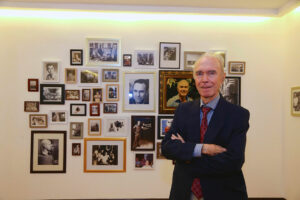Sansó: A story on art collectors

The great Spanish artist with a Filipino heart Juvenal Sansó, has passed to eternity. He takes his place among the pantheon of stars with his artist-friends and the art collectors who have gone before him.
There have been many wonderful tributes to his genius and his art, his many awards and achievements in the international art world.
As a friend, Sansó was always kind, affectionate, thoughtful, generous, and supportive. He was brilliant and had a sense of humor that was infectious. He clowned around during pictorials with photographers. He was always modest and self-effacing about his own accomplishments.
The witty raconteur was a good writer who shared his impressions on life and art collectors. He showed his keen observation of people and the process of authentication.
Here are excerpts from a personal letter (1990) he wrote that was first published in this column in 2015.
Maestro Sansó (or “Juvi” as close friends called him) had graciously accepted the invitation to mount a solo exhibit at the Artist’s Corner of the Hotel InterContinental Manila. This writer-artist was then the hotel’s PR director who managed the gallery. It was an honor to have worked closely with him. His spontaneous comments are still relevant in today’s environment.
He remarked, “I think that you will agree on what the painter feels about before and during the presentation of one’s works to the very wide variety of collectors, pseudo-collectors and studio wanderers.”
He wrote: “I must tell you a story that illustrates this purpose… Highly knowledgeable psychologists placed a monkey in a room filled with mirrors and all kinds of things used in a house to see what this animal would do in such circumstances.
“When the scientists put their eye in the keyhole to observe… Guess what they saw? They saw the monkey’s eye observing THEM!
“This happens to all artists who show paintings to prospective buyers in any place around the world. The Philippines in not an exception.”
He wrote an aside: “(I must underline the fact that I am not speaking of Filipino collectors exclusively… for someone might be offended if he or she thinks I am talking about him or her. My observations are a result of long years of practicing my vocation and its complement: that of presenting the works to the art — lover.)
“There are basic characters in the attitudes and strategies used by both sides that have a most interesting interplay of psychologies. I shall be underlining the most atypical of cases for they will allow us to understand that [there] are, in between the extremes, the kind and normal persons who only leave a happy aura behind when they leave.
“A very interesting case is the boyfriend of a wealthy business lady who was buying some of my works and who told him to do likewise. The poor fellow was in such a tight fix that he was sweating like a squeezed sponge all over the place… The perfect case of the napasubo. I could not release him from his predicament for I didn’t know what the intentions of the lady friend were; what kind of test he was going through. When confronted with another solution, classical.
“First, he was only going to like the ‘reserved’ or ‘sold’ items in the studio. When similar works were presented, he would want them in a different size. His perspiring was getting so bountiful that I had to take my books and drawings away from this human fountain. Seeing the poor fellow suffer so much and seeing how the lady seemed to push this torture, I kept on the fence, waiting for some release. I wonder what the score at the end was! He left without buying but maybe not earning his stripes with Lady Love, of course, he promised to come back… promises, promises!
“There are many ways that I use to judge if people in the studio are seriously interested in my works or simply taking a cultural paseo with his friends either to show how they know painting or the painter. If I hear too much chatting among my visitors, I may put a painting upside down to test their attention. If the second time I do this, they still have not reacted, then I terminate the presentation saying I don’t have any finished works to show. It’s best for everyone.
“Life is too short for me to devote time to indifference…
“In the studio, more than three or four viewers at a time are to be avoided because they form sub-groups chatting among themselves or try to impress one another with their knowledge and their culture. This verbal smarty-pants ping-pong never profits the artist for he or she rarely learns anything from the show-offs except how ignorant they are and how pedantic are the ones who know a bit.
“There is, sometimes, the decoration-oriented buyer who would rather choose a mediocre artwork that goes well with the curtains and wallpaper rather than a strong piece by a better painter…”
“I have relaxed and let each collector react according to his or her cultural capacity. What is important is that he or she makes the first step and feels motivated enough to spend hard-earned money on a painting.
“If the first step was the curtain, after a while, the painting dominates and projects its inner message. Eventually the curtain is changed. The curtain has no inner message from a sensitive human being. The kids grow up with art around them and this second generation will have seen the painting ‘first’ and forgotten the curtains.
“Authenticating by the artist himself is not a problem at all… I have a dozen elephants’ memory for my own works for they are a result of emotional, technical, stylistic factors that, at a glance, they come back to me…
“The immediate members of the family may be the second choice if the artist is dead; experts, assuming that the word expert is truly legitimate, may guide the collector to select the right (authentic) pieces. A reputable gallery is a very good base too… There are some, really!
“Buying directly from the artist (an honest artist, of course) is still the best guaranty of authenticity… straight from the carabao’s mouth: or the Monkey’s eye?”
Sansó was one of the most prolific, well-loved artists. His artworks are in the major collections of international museums and distinguished families around the world. He inspired a generation of artists.
Sansó was Catalan, born in Barcelona 95 years ago. He came with his parents and sister to Manila at age four. They founded the well-known Arte Español wrought iron furniture business.
A graduate of the University of the Philippines College of Fine Arts, he lived and worked in Paris for more than six decades. He traveled often but Manila was always his home. He spoke Spanish, French, and English. He used to startle people (with his piercing blue eyes) whenever he suddenly spoke in fluent Filipino!
The artist lives on in his exquisite artworks and in the hearts of the people who love him.
A blessed Easter to all!
Maria Victoria Rufino is an artist, writer and businesswoman. She is president and executive producer of Maverick Productions.




